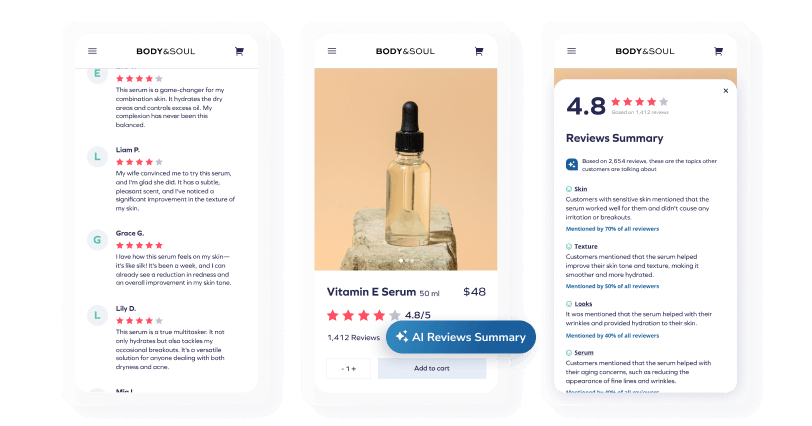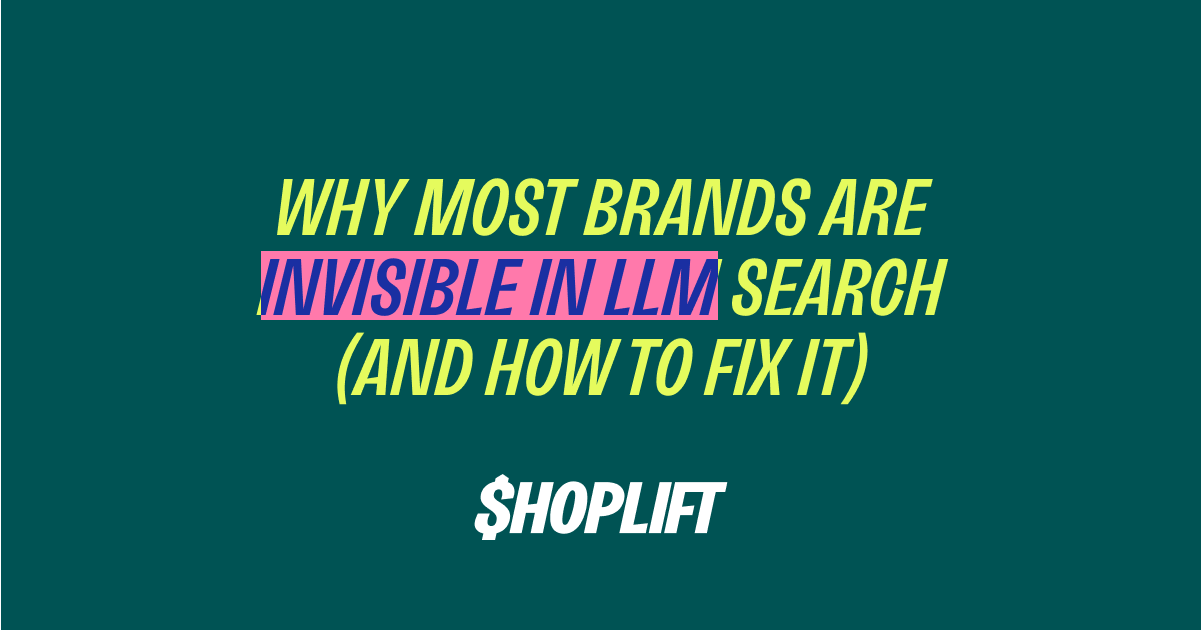Why Most Brands Are Invisible in LLM Search (And How to Fix It)
TL;DR
Half of purchase searches now happen on ChatGPT, yet most brands remain invisible in AI recommendations. The problem isn't brand awareness or product quality, it's machine readability. Yotpo's benchmarking of 100+ brands reveals six practical fixes that drive 25% conversion lifts and 3x visibility improvements. The first-mover window is open, but closing fast.
We're always looking for ways to help you boost conversions, which is why we're excited to share what our friends at Yotpo recently discovered. They've been digging into a massive shift in how shoppers find products, and what they found is pretty eye-opening. Turns out, half your potential customers are searching somewhere you probably aren't showing up yet.
Picture this: A shopper opens ChatGPT and asks, "What's a good natural shampoo for dyed hair?" Within seconds, they get specific brand recommendations. Your brand has the perfect product. Your reviews are glowing. But you're not in that list.
You're invisible.
According to a recent Yotpo survey, 50% of purchase searches now happen on ChatGPT. Not Google. Not Amazon. ChatGPT. And if you're not showing up there, you're missing half your potential customers.
Unlike previous search revolutions, this one happened without warning. No announcement, no transition period. One day, half your customers started searching where you don't exist. The irony? Brands with inferior products are showing up because they have superior machine readability.
The Visibility Crisis
After benchmarking 100+ brands across categories through CommerceGPT, Yotpo discovered a clear pattern. Winners and losers emerged, and it had nothing to do with brand size or product quality.
Major, legendary brands with massive marketing budgets show zero visibility in LLM search. Meanwhile, smaller DTC brands dominate the recommendations. What separates them?
The root cause isn't a brand awareness problem. It's a visibility infrastructure problem. Your reviews exist. Your product data exists. Your customer content exists. But it's all trapped in formats LLMs can't process.
Most brands think optimizing for Google will automatically make them visible in ChatGPT or Gemini. Wrong. As CommerceGPT Edition 04 notes, "AI platforms don't crawl like traditional search engines. They extract insights, summarize patterns, and surface brands that make that easy."
Here's the good news: Most brands, even big players, haven't addressed this yet. The first-mover window is wide open.
How LLMs Actually Work (And Why It Matters)
LLMs rank on completely different criteria than traditional search engines. They don't care about keyword density, backlinks, or ad spend. They prioritize three things: what they can crawl, what they can understand, and what they can trust.
When someone asks "Best heels for wide feet under $100?", LLMs look for content structured as answers, not product descriptions. They scan for patterns like "true to size," "runs wide," "soft material." If your reviews don't surface these attributes clearly, you're not part of the conversation.
The crawlability problem runs deep. Reviews trapped behind JavaScript, gated tabs, or blocked by robots.txt are invisible to LLMs. If the AI can't see it, your brand doesn't exist in that search.
Trust signals get weighted heavily. Verified purchase labels, loyalty program data, member tier levels, timestamps—these help LLMs decide which brands to recommend and rank higher. Raw, unorganized reviews are harder to interpret than AI-generated summaries showing pros and cons with key attributes.
One more thing: LLMs operate across languages seamlessly. If your reviews aren't translated, you're invisible in international markets even when your products ship there.
Six Ways to Fix Your LLM Visibility
1. Make Your Reviews Crawlable
This is the basic step most brands miss. Reviews need to live on a dedicated, crawlable page (for example, yoursite.com/pages/reviews), not just embedded in product pages.
Check your robots.txt file and ensure you're not blocking crawlers. Remove noindex tags that prevent LLM access. If your reviews load only through JavaScript formats, LLMs can't read them. Your brand is effectively invisible.
This is often the fastest fix with the biggest impact. You're making existing content accessible rather than creating new content.
2. Add Review Summaries and Structure
LLMs scan for patterns. Dumping raw reviews on your site makes their job harder.
Use AI-generated summaries to surface key attributes and themes automatically. Display the most mentioned pros and cons like "true to size" or "soft material." Include verified purchase labels and timestamps to give LLMs the credibility signals they're looking for.
The proof is in the results. Yotpo brands that enabled structured review summaries saw up to a 25% lift in conversion and 3x higher visibility in AI-generated shopping flows.
3. Use Q&A Format Wherever Possible
LLMs love answers. If your content mirrors how people ask questions, you'll get cited more often.
Add FAQs to your product pages with questions like "Is this safe for sensitive skin?" Include these in your schema markup so LLMs can easily parse them. When customers answer questions in reviews, highlight those as FAQs.
CommerceGPT Edition 06 explains it clearly: "The best way to rank in Gemini is to show up in ChatGPT. And the best way to show up in ChatGPT is to structure your content like it's answering questions, not just describing features."
Brands that reframe product details as answers appear in Gemini AI snapshots and ChatGPT shopping prompts.
4. Translate Your Reviews
LLMs are multilingual by default. They search and recommend across languages seamlessly. Are your reviews keeping up?
Yotpo customers using multilingual reviews are more likely to surface globally in LLM recommendations. Include native-language testimonials when selling in international markets, not just translated product descriptions.
CommerceGPT Edition 05 showed that brands with translated review content got broader AI visibility across regions. As the research notes, "Brands who translated reviews and added summaries weren’t just easier to find—they got more trusted by AI systems interpreting intent."
5. Leverage Loyalty Signals as Trust Signals
AI systems prioritize brands they deem trustworthy when making recommendations. Loyalty metadata helps establish that credibility.
Highlight "Member since" dates or tier levels in review displays. Use verified buyer labels and rewards activity data to show real customer relationships. Surface user-generated content from loyal, high-tier customers—it carries extra weight with LLMs.
LLMs want to reflect what real, loyal customers love, not just one-time purchasers. That's your competitive edge.
6. Check Your Technical Hygiene
Explicitly allow crawlers like Googlebot, GPTBot, Gemini, and Claude to access your product, review, and content pages. Ensure your sitemap is submitted and includes all key UGC pages.
One brand in Yotpo's benchmark accidentally blocked their entire review library with a wildcard disallow rule. They fixed it, and started showing up in AI product lists two weeks later.
Technical configuration isn't set it and forget it. Review quarterly as LLM crawlers evolve.
The Real Opportunity
Most brands haven't optimized for LLM search yet. Even major, well-funded competitors are missing from AI recommendations. This creates a rare opportunity for savvy merchants who move now.
You're not starting from scratch. Most brands already have strong reviews, loyalty programs, and customer data. The challenge is making it machine-readable, structured, and discoverable. Not creating content, but making existing content work harder.
Brands that move now don't just get visibility. They get the data and learnings to stay ahead as LLM search evolves. Early optimization creates feedback loops that improve performance over time.
The infrastructure matters more than individual tactics. Piecemeal solutions—fixing reviews here, loyalty there—fall short. Yotpo is the only platform connecting reviews, loyalty, and Q&A content in a way that LLMs actually use, creating unified, trustworthy signals.
The integration ecosystem amplifies results. Brands using Shoplift for A/B testing can now test LLM-optimized content variations to see what drives the best visibility and conversion outcomes. The combination of Yotpo's infrastructure and Shoplift's testing capabilities gives merchants a complete optimization toolkit.
Leading Shopify merchants are already leveraging this approach and seeing measurable gains in AI-driven traffic and conversions.
Ready to Show Up Where It Matters?
If your brand isn't showing up in LLM search, it's not about brand awareness or product quality. It's about having the right infrastructure to make your content machine-readable, structured, and trustworthy.
You already have the assets. Strong reviews, loyal customers, product knowledge—these exist in your business today. The work is making them accessible to the AI systems where half your customers are now searching.
Yotpo is the only platform purpose-built to connect reviews, loyalty, and Q&A content in formats that LLMs actually use and trust. They're already helping leading brands show up in AI recommendations, and they're ready to do the same for you.

Book a personalized Yotpo demo where they'll:
- Analyze your current review structure and identify visibility gaps
- Walk you through practical fixes specific to your brand
- Share how other brands in your category used Yotpo to increase AI-driven traffic and conversions
- Show the integrated approach that makes LLM optimization sustainable, not a one-time fix
Book your demo here and ensure your brand shows up where half your customers are searching.
Frequently Asked Questions
What is LLM search and why should I care about it?
LLM search refers to AI-powered platforms like ChatGPT and Google Gemini that customers use to find product recommendations through conversational queries. With 50% of purchase searches now happening on these platforms, optimizing for LLM visibility is critical for reaching today's shoppers.
How is LLM search different from traditional SEO?
LLMs prioritize machine-readable content, structured data, and trust signals rather than keywords and backlinks. Your reviews need to be crawlable, organized, and formatted as answers to appear in AI recommendations, regardless of your traditional SEO rankings.
Do I need to create new content to show up in LLM search?
Most brands already have the content they need through existing reviews, loyalty data, and customer Q&A. The challenge is making that content accessible and structured so LLMs can process it, not creating content from scratch.
How long does it take to see results from LLM optimization?
Some brands see visibility improvements within two weeks of fixing technical issues like blocked crawlers. More comprehensive optimizations like structured reviews and multilingual content typically show measurable impact within 30-60 days.
Can small brands compete with major retailers in LLM search?
Yes, LLM search creates a more level playing field since AI recommendations prioritize machine-readable, trustworthy content over brand size or ad spend. Yotpo's benchmarking shows smaller DTC brands often outperform legacy retailers who haven't optimized their review infrastructure.





